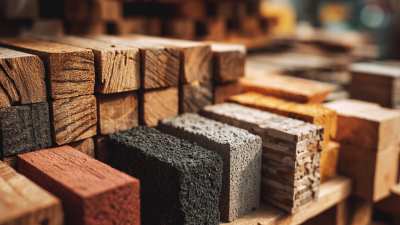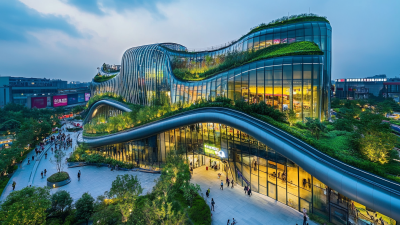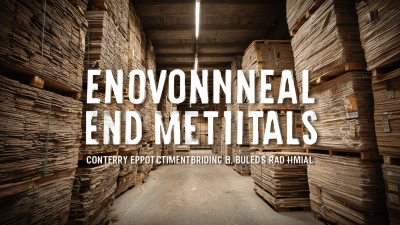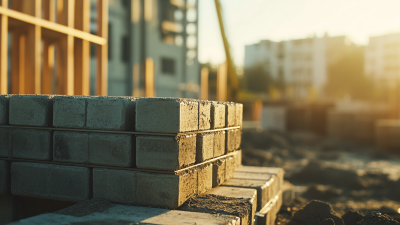Natural beauty for your favorite space
Revolutionizing Construction: The Ultimate Guide to Eco Friendly Building Materials for a Sustainable Future
In today's rapidly evolving world, the construction industry plays a pivotal role in shaping sustainable practices and minimizing environmental impact. As awareness of climate change and resource depletion grows, builders and architects are increasingly turning to Eco Friendly Building Materials to create structures that not only meet modern aesthetic demands but also promote ecological balance. This ultimate guide aims to provide insightful tips and strategies for selecting and implementing these innovative materials in construction projects.
By embracing eco-friendly alternatives, we can revolutionize the way we build, ensuring that our infrastructure supports a sustainable future for generations to come. From recycled content to renewable resources, the options available today empower us to construct buildings that are not only functional but also align with the principles of environmental stewardship. Join us as we explore the myriad benefits and practical applications of Eco Friendly Building Materials in transforming our built environment.

The Importance of Eco-Friendly Materials in Modern Construction
In modern construction, the importance of eco-friendly materials cannot be overstated. As industries strive to reduce their carbon footprint, the adoption of sustainable building materials has become a necessity rather than an option. According to a report by the World Green Building Council, buildings account for 39% of global carbon emissions, with operational energy use alone contributing to 28%. This highlights the urgent need for innovative materials that not only minimize environmental impact but also enhance energy efficiency.
Eco-friendly materials, such as bamboo, recycled steel, and reclaimed wood, are gaining traction for their sustainability and durability. A study by McGraw Hill Construction revealed that 37% of builders cited eco-friendly materials as a key driver for their projects, showcasing a shift in industry priorities. Moreover, using recycled materials has been shown to reduce energy consumption during production by up to 80%, making them a critical component in the pursuit of sustainable architecture. As the construction landscape evolves, integrating these materials will be crucial for creating a greener future while meeting the demands of urbanization and climate change.

Innovative Alternative Materials Transforming the Building Industry
The construction industry is undergoing a significant transformation as innovative alternative materials emerge to address the pressing need for sustainability. These materials not only reduce environmental impact but also enhance the overall efficiency and durability of buildings. For instance, bamboo, known for its rapid growth and strength, is being utilized in various structural applications, while mycelium-based composites offer biodegradable options for insulation and packing materials. These alternatives provide eco-friendly solutions that challenge the traditional reliance on concrete and steel.
In addition to natural materials, recycled products are gaining traction, with companies developing bricks made from industrial byproducts and plastics. This shift not only diminishes waste but also promotes a circular economy within the construction sector. Innovations such as 3D-printed homes using sustainable concrete mixtures exemplify how technology can marry functionality with environmental responsibility. As these alternative materials gain popularity, they are paving the way for a future where building practices align more closely with ecological principles, creating structures that are not only functional but also harmonious with the planet.
Sustainable Sourcing: How to Choose Eco-Friendly Construction Supplies
When it comes to sustainable sourcing of construction materials, it is vital to prioritize eco-friendly options that minimize environmental impact. Begin by researching materials that are renewable, such as bamboo, reclaimed wood, and recycled metal. These materials not only help reduce waste but also contribute to a circular economy by repurposing old products into new building supplies. Look for certifications like Forest Stewardship Council (FSC) for wood products to ensure sustainable harvesting practices.
Another crucial factor in selecting eco-friendly construction supplies is assessing the lifecycle of materials. Consider their durability, energy efficiency, and potential for recycling at the end of their lifespan. For instance, opting for high-performance insulation made from recycled materials can reduce energy consumption significantly. Additionally, prioritize local suppliers to lower transportation emissions and support regional economies. By making informed choices, builders can foster a sustainable future while also enhancing the resilience of our built environment.
Impact of Eco-Friendly Building Materials on Energy Efficiency
The impact of eco-friendly building materials on energy efficiency cannot be overstated, as the construction sector accounts for approximately 39% of global carbon emissions, according to the Global Alliance for Buildings and Construction. By integrating sustainable materials, such as recycled steel, bamboo, and rammed earth, builders can significantly reduce energy consumption. For instance, the use of insulated concrete forms (ICFs) can enhance energy efficiency, allowing for a reduction of heating and cooling costs by up to 50%, as reported by the Portland Cement Association.
Moreover, eco-friendly materials contribute to better indoor air quality and overall environmental sustainability. Materials like low-VOC (volatile organic compounds) paints and finishes not only minimize harmful emissions but also promote healthier living spaces. A study from the National Institute of Standards and Technology indicates that improving indoor environments through sustainable materials can lead to a 10-20% increase in productivity and cognitive function of occupants. Investing in eco-friendly building materials not only meets the demand for sustainable construction but also propels the industry towards a more energy-efficient future.
Case Studies: Successful Projects Implementing Green Building Practices
One of the most compelling examples of successful green building practices can be seen in the Bullitt Center in Seattle, often dubbed the "greenest commercial building in the world." This building utilizes a mix of sustainable materials, such as reclaimed wood and high-performance glass, which not only reduce its carbon footprint but also enhance energy efficiency. By integrating solar panels and a rainwater harvesting system, it sets a benchmark for sustainable design in urban settings, demonstrating that eco-friendly construction can be both functional and aesthetically appealing.

Another inspiring case is the Bosco Verticale in Milan, Italy, a residential project that incorporates vertical gardens into its structure. These living walls not only improve air quality but also provide insulation, reducing energy costs. The use of local materials further minimizes environmental impact, highlighting how green architecture can contribute positively to urban biodiversity while meeting residents' needs.
Tips for Implementing Green Building Practices:
- Start by conducting an energy audit of your current project to identify areas for improvement.
- Choose sustainable materials that have low environmental impacts, such as bamboo, recycled steel, or reclaimed wood.
- Consider incorporating renewable energy sources, like solar panels, to reduce reliance on fossil fuels and create a self-sustaining building environment.
Related Posts
-

Essential Checklist for Sourcing Eco Friendly Building Materials Globally
-

Advantages of Choosing Sustainable Construction Materials for Global Buyers
-

Top 10 Eco-Friendly Building Materials Manufacturers from China at the 137th Canton Fair
-

How to Navigate Import Export Certifications for Best Environmentally Friendly Building Materials
-

Benchmarking Eco Sustainable Construction Materials for Global Buyers
-

Exploring the Surge in Global Demand for Most Environmentally Friendly Building Materials at the 137th Canton Fair
